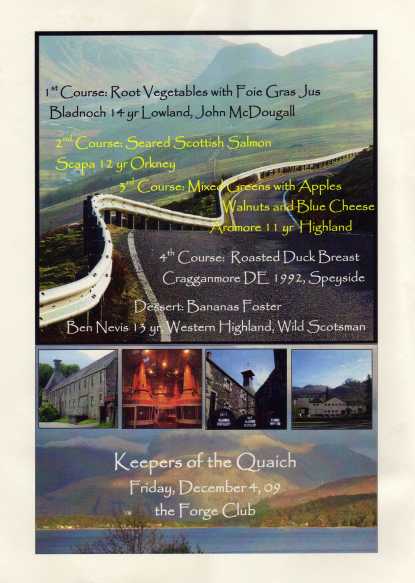Brother Bop was kind enough to assign me to select 5 active distilleries that the KOTQ has never tasted that I would like future fir en tighes (hosts) to consider for an upcoming meeting in 2o10. One of the things I found is this appearance of debate within Scotland of bringing single malts to more people with fancy drink recipes and slick websites that would appeal to a younger audience vs. the classic “here’s your single malt, open it, drink it neat, seal it… repeat”.
Here is my 5 (with some slight edits from the temporary list I had at the meeting – didn’t finish because our site was down…)
1 –Glenglassaugh – Speyside – This distillery closed for 22 years 1986 – 2008 but has reopened and still has an impressive, albeit limited availability, vertical lineup as well as an exciting new spirit dubbed “The Spirit Drink that dare not speak its name”. The Spirit Drink cannot be called scotch whisky because it was bottled before it had aged the requisite 3 years… something for us to consider… a single malt < 3 yrs old… what is it like? Should we drink it with a mixer (blasphemy?)
2 – Isle of Jura – Jura – By far my favorite site with one of the best embedded videos of a Scotch purist facing off with a French mixologist debating the merits of true scotch whisky drinking vs. making it more “accessible” to the masses (mixing / etc.) I had failed to recognize Brother Tao’s prior posting of this phenomenal short but if you haven’t seen it, check out – http://www.isleofjura.com/richardandcolin/detail.cfm?contentid=349 Also, interesting fact – Jura has roughly 30x more deer than people on the island… The 16yr expression is their bread and butter but they have some nice differentiation/variation as well…. check them out!
3 – Tomatin – Northern Highland – Huge producer – >5MM litres per year… and yet we’ve never had their spirit flow down our collective palates or uttered a kind description of the body of this fine whisky. Additionally, they’ve been owned by the Japanese since 1985 and I’m curious to know if they’ve influenced the process at all, whether it be from an economic / political / or process point of view. Additionally, given their size, they have nice vertical potential from an expression perspective.
4 – Arran – Isle of Arran (Lochranza) – Distillery opened in 1995 and has done some rather interesting things… including some traditional and avant garde finishings to their main expression – 10yr. I really debated adding this one because they do promote recipes on their site that would involve mixing the 10yr with other liquids, but they have a nice lineup and we have some finishing fans (see Tao, Balgum, etc.)
5 – Tomintoul – Speyside – Another very large producer – > 3MM liters / year and a nice product mix. Also, their claim to fame is the World’s Largest Whisky Bottle (per Guiness Book of Records) – 5 ft tall and the equivalent of 150 std bottles (750ml),…. Quite a number of their products are available locally, which was a key factor as I started to get further down the list. There were a number of others that were like 5b – 5n but I picked this distillery because it could be easily rotated in and has a nice history we could research further.
Slainte! I’m getting parched just writing this….


